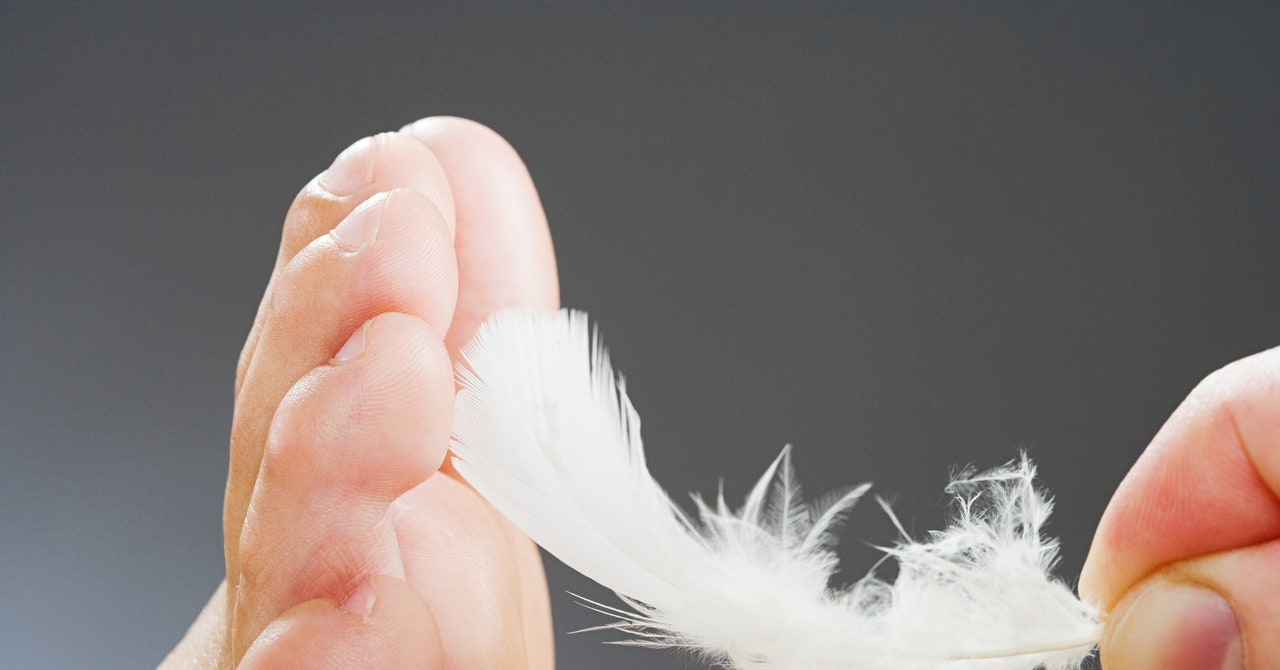
In the new study’s first phase, each subject had their moment in front of the GoPros and microphone. Previous studies have established that tickling is mood-dependent—anxiety and unfamiliarity suppress it like a wet blanket. Since participants would have to take turns tickling each other, Brecht’s team made sure each pair knew each other beforehand and felt comfortable—but each person was still surprised by the actual tickling attack. The tickler always hid behind their partner, while watching a videoscreen that fed them randomized sequences of body parts to touch. Neck, armpit, lateral trunk, plantar foot, crown of the head—each spot got five quick tickles.
The first observation: a person’s facial expressions and breathing changed about 300 milliseconds into a tickle. (The write-up describes the poetry caught on GoPro footage: The ticklee’s cheeks raised, the corner of their lips pulled outward, “the occurrence of which in combination signals a joyous smile.”)
Then, at about 500 milliseconds, came the vocalization—surprisingly late. (A normal vocal reaction time to being touched is about 320 milliseconds.) The team suspects that laughs take longer because they require more complicated emotional processing.
The subjects also rated how ticklish each touch was. The crown of the head is not usually ticklish, so it served as a control for what happens when you tickle someone in a not-responsive spot. Volunteers laughed audibly after about 70 percent of touches, and the more intensely they felt the tickle, the louder and higher pitched they laughed. In fact, the sound of their laughter was the measure that best correlated with their subjective ratings of how intense each tickle had felt.
In the next phase of the experiment, the ticklers did the same thing, while their partners simultaneously tickled themselves—either in the same spot on the opposite side of the body, just beside it, or in a hovering pretend-tickle that never actually touched the skin.
As expected, self-tickling was uneventful. But the team noticed something weird: Self-tickling made the other person’s tickle less intense. On average, the occurrence of ticklee giggling dropped by 25 percent, and was delayed to almost 700 milliseconds when self-tickling the same side. “It was a surprise to us,” Brecht says. “But it’s very clear in the data.”
Why might this be? It goes back to the question of why we can’t tickle ourselves. The leading theory holds that tickling provokes laughter thanks to a prediction error by the brain. An unpredictable touch confuses it, sending it into a mini frenzy. Self-touch is always predictable … so, no frenzy.
But Brecht thinks it’s not really about prediction. Instead, he suggests that as a person touches themselves, the brain sends out a body-wide message that inhibits touch sensitivity. “We think what is happening is the brain has a trick to know: As soon as you touch yourself, don’t listen,” he says. If it didn’t, he argues, we’d all be constantly tickling ourselves every time we scratched an armpit or touched our toes.
This makes sense, says Sophie Scott, a cognitive neuroscientist from University College London not involved in the work, because our brains learn to turn down sensory perceptions when our actions are contributing to them. “Sitting right now, I’m generating a lot of physical sensations in my body just by my movement. And that’s much less important to me to know about than whether somebody else came in the room and touched me,” she says. In fact, she continues, the same dimming effect happens with hearing. When you speak, the parts of your brain that listen to other people talking are suppressed. (That’s why, she says, “People are very bad at judging how loud they’re speaking.”) So if the brain is inhibiting reactions to touch while self-tickling, it would also be inhibiting reactions to being tickled by someone else.


